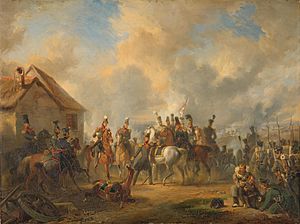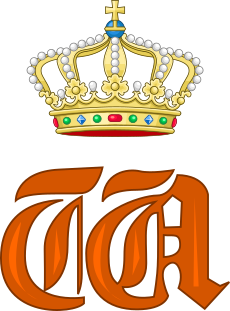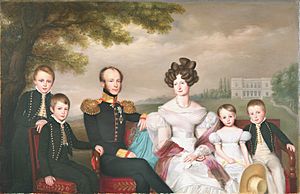William II of the Netherlands facts for kids
Quick facts for kids William II |
|
|---|---|
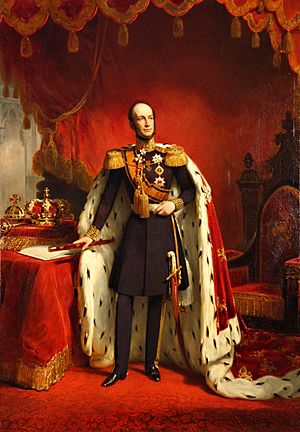
1849 portrait by Nicolaas Pieneman
|
|
|
|
| Reign | 7 October 1840 – 17 March 1849 |
| Inauguration | 28 November 1840 |
| Predecessor | William I |
| Successor | William III |
| Born | 6 December 1792 Noordeinde Palace, The Hague, Dutch Republic |
| Died | 17 March 1849 (aged 56) Tilburg, Netherlands |
| Spouse | |
| Issue |
|
| House | Orange-Nassau |
| Father | William I of the Netherlands |
| Mother | Wilhelmine of Prussia |
| Religion | Dutch Reformed Church |
William II (born Willem Frederik George Lodewijk; 6 December 1792 – 17 March 1849) was the King of the Netherlands, Grand Duke of Luxembourg, and Duke of Limburg. He was the son of King William I.
When his father became king in 1815, William became the Prince of Orange. This title meant he was the next in line to the throne. He became king himself on 7 October 1840, after his father stepped down. During his time as king, the Netherlands changed to a parliamentary democracy. This happened with a new constitution in 1848.
William II was married to Anna Pavlovna of Russia. They had five children together. He died on 17 March 1849, and his son William III became the next king.
Contents
Early Life and Education
William Frederik George Lodewijk was born on 6 December 1792 in The Hague. He was the oldest son of King William I and Wilhelmine of Prussia.
When William was two years old, his family had to leave their home. They fled to England because French troops entered the Netherlands. William spent his childhood in Berlin, Prussia. There, he received military training and served in the Prussian Army. Later, he studied law at Christ Church, part of the University of Oxford.
Military Career
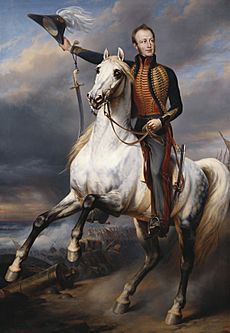
William joined the British Army in 1811. As a young officer, he worked with Arthur Wellesley, 1st Duke of Wellington during the Peninsular War. He was promoted quickly, becoming a major-general by 1813. The British liked him for his bravery and good nature, calling him "Slender Billy".
In 1813, he returned to the Netherlands when his father became the sovereign prince. He then became the highest-ranking British officer in the Netherlands. In 1815, when Napoleon I of France escaped from Elba, William was a senior officer in the Allied army. He fought in the Battle of Quatre Bras and the Battle of Waterloo. At Waterloo, he was wounded in his left shoulder. He was only 22 years old.
As a thank you for his role at Waterloo, the Dutch people gave William Soestdijk Palace.
Marriage and Family
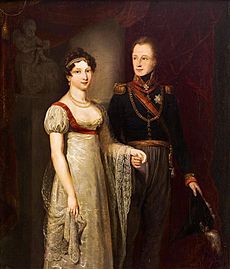
In 1814, William was briefly engaged to Princess Charlotte of Wales. She was the only child of the British Prince Regent. However, the engagement ended because Charlotte did not want to move to the Netherlands.
On 21 February 1816, William married Grand Duchess Anna Pavlovna of Russia. She was the youngest sister of Czar Alexander I of Russia. This marriage helped strengthen the relationship between Russia and the Netherlands. Their first son, Willem Alexander, who would become King William III, was born in Brussels in 1817.
Belgian Revolution
William II was quite popular in what is now Belgium. In 1830, when the Belgian revolution began, he tried to find a peaceful solution. He suggested that the southern provinces (Belgium) should have more self-rule. However, his father, King William I, disagreed with his ideas. This caused tension between them.
In April 1831, William II led the Dutch army during the Ten Days' Campaign. This was an effort to regain control of Belgium. The Dutch army had some early success, but they withdrew after France intervened to support the rebels. Eventually, Leopold of Saxe-Coburg-Gotha became the king of a new, independent Belgium. Peace was finally made in 1839 when the Netherlands officially recognized Belgium.
Becoming King and Reforms
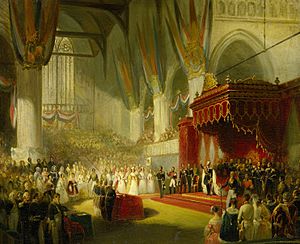
On 7 October 1840, William II became king after his father stepped down. Unlike his father, he did not get involved in government matters as much. At this time, many people wanted big changes to the constitution and more voting rights. Even though William was not a strong supporter of democracy, he acted wisely.
In 1848, revolutions broke out across Europe. The king of France was overthrown. William was worried that a revolution might spread to the Netherlands. So, he decided it was better to offer reforms himself. He famously said, "I changed from conservative to liberal in one night." He chose a group led by Johan Rudolf Thorbecke to write a new constitution.
The new constitution made important changes. The Eerste Kamer (Senate) would now be chosen by provincial governments. The Tweede Kamer (House of Representatives) would be directly elected by citizens who paid a certain amount in taxes. Most importantly, government ministers now had to answer to the Tweede Kamer. This meant that the real power shifted to the elected representatives, and the king became more of a figurehead. This constitution, with some updates, is still used in the Netherlands today.
King William II passed away suddenly in Tilburg in 1849, just a few months after the new constitution was put into effect.
Honours
William II received many awards and honours during his life, including:
 Netherlands: Grand Cross of the Military William Order, 8 July 1815
Netherlands: Grand Cross of the Military William Order, 8 July 1815 Luxembourg: Founder of the Order of the Oak Crown, 29 December 1841
Luxembourg: Founder of the Order of the Oak Crown, 29 December 1841 Kingdom of Prussia: Knight of the Order of the Black Eagle, 17 December 1808
Kingdom of Prussia: Knight of the Order of the Black Eagle, 17 December 1808 Russian Empire: Knight of the Order of St. Andrew, 22 June 1814
Russian Empire: Knight of the Order of St. Andrew, 22 June 1814 Spain: Knight of the Order of the Golden Fleece, 18 September 1814
Spain: Knight of the Order of the Golden Fleece, 18 September 1814
Children
William II and Queen Anna Pavlovna had five children:
- William Alexander Paul Frederick Louis (1817–1890), who became King William III.
- William Alexander Frederick Constantine Nicolas Michael (1818–1848), also known as Sascha. He never married.
- William Frederick Henry (1820–1879), known as "the Navigator". He married twice but had no children.
- William Alexander Ernst Frederick Casimir (1822), who died as a baby.
- Wilhelmina Marie Sophie Louise (1824–1897), who married Karl Alexander, Grand Duke of Saxe-Weimar-Eisenach, and had children.
See also
 In Spanish: Guillermo II de los Países Bajos para niños
In Spanish: Guillermo II de los Países Bajos para niños
- Orange, New South Wales, an Australian city named for William II.
- Place Guillaume II, a square in Luxembourg City.
- Willem II (football club), a Dutch football club from Tilburg named after the King.


